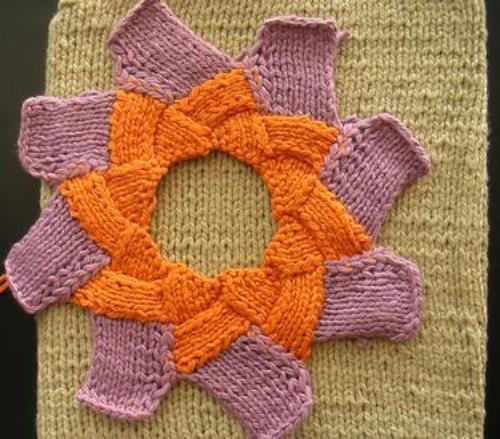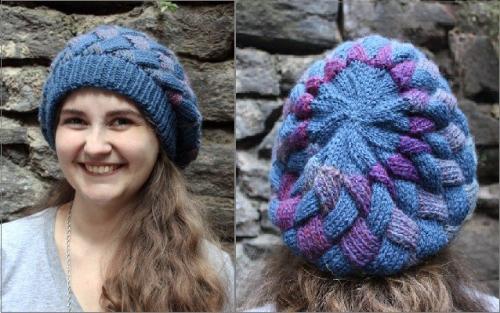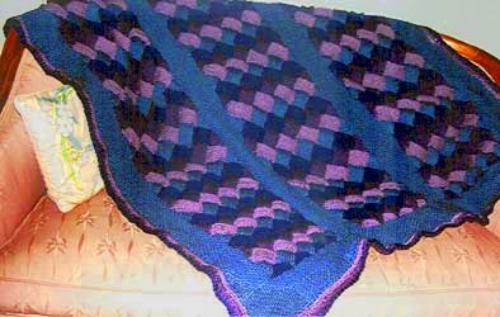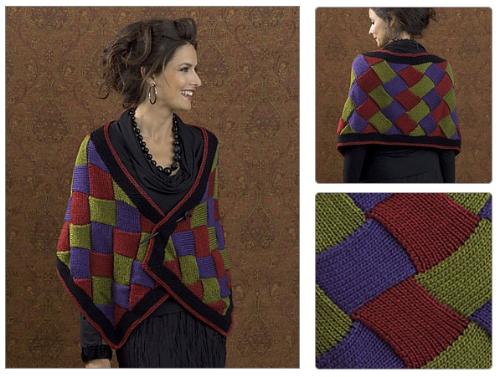The afghan can be made longer (make the entrelac strips longer) or wider (add another panel). Remember to adjust the amount of yarn.
The afghan can be made longer (make the entrelac strips longer) or wider (add another panel). Remember to adjust the amount of yarn.
Materials:
Patons Decor
75% acrylic/25% wool
210 yards/100 grams
3 balls Deep County Blue #1623 (Color A)
7 balls Rich Country Blue #1622 (Color B)
3 balls Aubergine #1623 (Color C)
3 balls Rich Aubergine #1627 (Color D)
Size 6 US (4.25 mm) 30 inch circular needle or size needed to obtain gauge
Size H crochet hook
Gauge:
20 sts and 28 rows = 4 inches (10 cm)
Approximate Size:
42" by 57"
IntstructionsEntrelac Panels
With Color A CO 32 sts and work base triangles as follows:
*K1, turn, P1, turn
K2, turn, P2, turn
K3, turn, P3, turn
Continue in this manner until you reach K8; do not turn.
Rep from * three times more.
Entrelac Row 2 (end triangle with WS facing)
With Color B:
P1, turn, inc in this st, turn
P1, P2tog, turn, inc in first st, K1, turn
P2, P2tog, turn, K1, inc in next st, K1, turn
P3, P2tog, turn, K2, inc in next st, K1, turn
P4, P2tog, turn, K3, inc in next st, K1, turn
Continue in this manner until you reach P7, P2tog; do not turn.
Full entrelac with WS facing
*With color C, pick up 8 sts purlwise along the edge of the triangle/rectangle directly underneath and work as follows:
Row 1: Knit, turn
Row 2: P7, P2tog, turn
Rep these 2 rows 8 times but do not turn after the last purl row.
Rep from * twice more.
End triangle with WS facing
Pick up 8 sts purlwise, turn
K8, turn
P6, P2tog, turn, K7, turn
P5, P2tog, turn, K6, turn
P4, P2tog, turn, K5, turn
P3, P2tog, turn, K4, turn
Continue decreasing in this manner until one st remains.
Fasten off.
Entrelac Row 3 (Full entrelac with RS facing):
Turn so you have the RS facing you.
With Color D, *pick up 8 sts knitwise along the inside edge of the end triangle just worked.
P8, turn, K7, SSK, turn
Rep 8 times but do not turn after last row.
Rep from * 3 times more, picking up the sts from the edges of the entrelacs as they present themselves.
Continue working, alternating colors A, B, C, and D.
Knit 43 complete entrelacs.
There will be a ½ square at the beginning.
BO on the 44th square.
BO as follows:
*Pick up 8 sts along the edge of the edge triangle just worked on the previous row, turn
P8, turn, K7, SSK, turn
P6, P2tog, turn, K6, SSK, turn
P5, P2tog, turn, K5, SSK, turn
P4, P2tog, turn, K4, SSK, turn
Continue decreasing in this manner until one st remains.
Fasten off, but do not break yarn.
Rep from * 3 more times, picking up sts along edges of entrelacs as they present themselves.
BO.
For the center panel, use the color order D, C, B, and A. Make three panels in all.
Borders
The border is a pattern called Tanbark. To begin, take the center entrelac panel and pick up approximately 217 stitches with Color B. The RS of the entrelac should be facing you with the long edge facing you. The exact number is not critical, but it must be an odd number. The border pattern is very dense, so you need enough sts to make the panel long enough. It is helpful to place a marker every 20 stitches to keep track of the pattern.
Row 1 (WS): p1, *sl1 wyif, p1; rep from *
Row 2: p1, *k1, p1; rep from *
Row 3: sl1 wyif, * p1, sl1 wyif; rep from *
Row 4: k1, *p1, k1; rep from *
Rep these 4 rows for 3 inches or 34 rows. BO. Work the pattern for three inches (34 rows) and BO.
Pick up 217 stitches on the other side of the center panel and knit in Tanbark as for the first panel. Knit a panel of Tanbark on the outside edges of the two remaining panels.
Block
Do not press. Wash gently and pin out without stretching the knitting. When dry the entrelacs should be somewhat three-dimensional. The entrelac will pull up with the border, which is dense.
Finishing
Seam center and side panels. Knit the top and bottom in the Tanbark pattern, picking up approximately 193 stitches at each end and working 3 inches (34 rows).
With Color B, single crochet around the outside edge of the afghan.
Change to Color C and triple crochet around the outside edge once.
Change to Color D and triple crochet around the outside edge once.
Change to Color A and double crochet around the outside edge once
Souce: http://www.knittingonthenet.com/patterns/afentrelac.htm
























